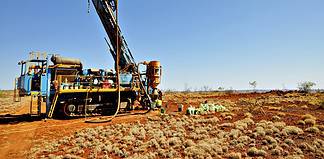IT’S full steam ahead for Rio Tinto’s $2.6b Amrun bauxite mine on the Cape York Peninsula in Queensland.
The mine and associated processing and port facilities will replace production from Rio Tinto’s depleting East Weipa mine, and increase annual bauxite export capacity by around 10mt, at a time when higher-grade bauxite is becoming scarcer globally.
It’s a major milestone for the operations, which were approved in 2015, with its March commissioning this year well in advance of the target starting date.
Rio Tinto made Amrun’s first shipment in December 2018, six weeks ahead of schedule, and at full production, Amrun is expected to dispatch 22.8mt a year, with options to expand.
At the peak of construction, 1200 people worked on site. Since project inception, close to 400 Aboriginal and Torres Strait Islander people have been employed by the project.
Rio Tinto chief executive Jean-Sébastien Jacques said Amrun had been completed early and under budget, demonstrating Rio Tinto’s productivity and innovation capabilities.
“By applying fresh thinking we also delivered safety, environmental, cost and timing benefits,” he said.
“Amrun will provide jobs, support businesses and contribute to growth in the region for the next 50 years, building on $2.2 billion of contracts with local, State and national businesses during construction.”
The development was hailed by Queensland Premier Annastacia Palaszczuk, who said Weipa’s bauxite would be used to make aluminium for mobile phones, aeroplanes, vehicles and many other applications around the world.
“The Amrun project is one of the sector’s proudest achievements,” she said.
Modular methodology
In an industry first, Amrun’s 1km-long export facility was built in modules off-site and then brought to Amrun and connected.
This reduced over-water construction and painting in the culturally significant and environmentally sensitive region and reduced construction time by a year.
It also increased safety by removing the need for 300,000 work hours that would have been spent at height and over water.
Rio Tinto Growth and Innovation group executive Steve McIntosh said game-changing innovations and collaborations such as these were vital for advancing the future of the mining and metals industry globally in a safe, cost-effective and replicable manner.
The project included completion of key infrastructure such as the Amrun power station, accommodation village, Chith export facility and Arraw dam, as well as process facilities, rail mounted machines, Amrun mine centre, and Torro tailings storage facility.
An advanced commissioning team responsible for plant and ship loader operations was employed, while a development team oversaw clearing and topsoil stripping.
The final piece of infrastructure for the project, the ship loader, followed a seven-day voyage from WA to Queensland.
The loader was fabricated into three main modules by Civmec at its WA facility after it was awarded a contract by Sandvik to support the project.
Fabrication and assembly construction took place over an eight-month period followed by four weeks of commissioning. At its peak the contract created employment for 100 people.
The remoteness of the Amrun site meant the safest and most efficient way to approach this type of construction was to fabricate the infrastructure into large-scale modules.
The off-site strategy enabled design and fabrication issues to be realised earlier reducing construction man hours and associated safety, quality and costs risks.
Staying local
Amrun said the achievement was another example of the project’s commitment to showcasing best practice Australian manufacturing expertise, delivering local jobs and providing a boost to the Australian economy.
The company is proud that innovation is used at the heart of Amrun.
During construction, it used virtual reality to show the local community and traditional owners how the area would look once project infrastructure was finished.
And it used creative engineering techniques to build the mine’s wharf in a way that was safer, faster and left a lighter footprint on the local environment than more traditional methods.
Rio Tinto has a long history of partnering with traditional owners on Cape York, with Aboriginal and Torres Strait Islander people making up one in four employees at its existing Western Cape operations.
The Amrun mine is expected to continue creating opportunities for Indigenous people from Cape York and the surrounding region.
The company works closely with traditional owners to understand their special connection to country, tapping into their unique knowledge of the land to make sure areas are looked after properly during mining, and guiding how land is revegetated for future generations.
“Since the Amrun project’s approval in 2015, we placed a strong emphasis on providing opportunities for Queensland businesses to contribute to the project through our Local and Indigenous Participation Plan,” Mr Jacques said.
“This approach has provided a significant boost to the Queensland economy and to the people in the communities where we operate.
“We are proud of our contribution as it will represent a new chapter in Rio Tinto’s 60-year history on the Western Cape.”








































